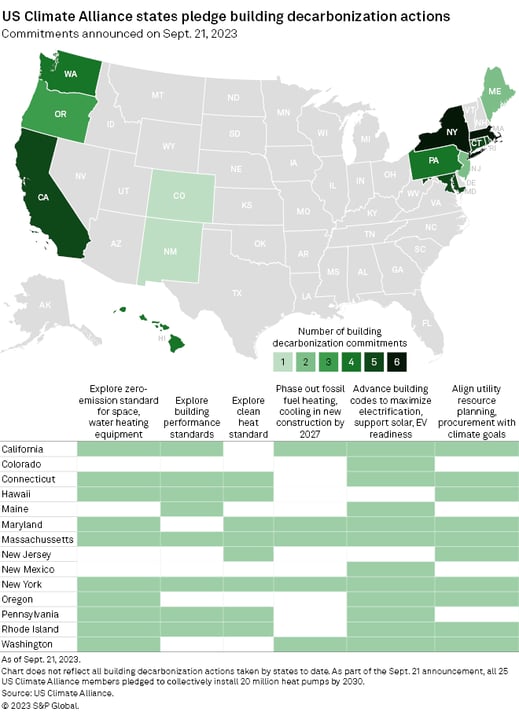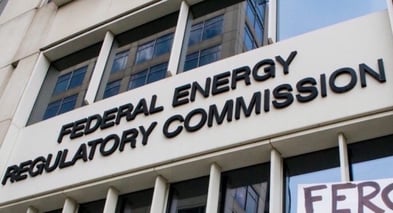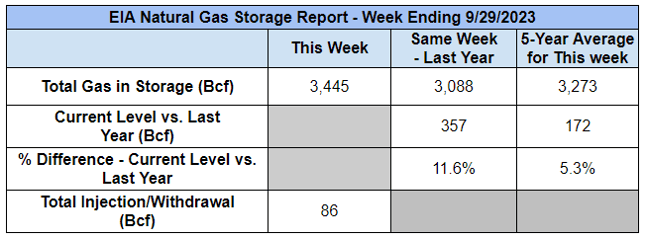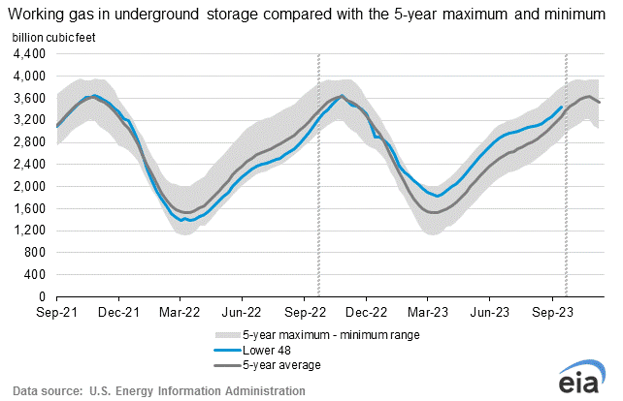Energy Markets Update
Weekly natural gas inventories
The U.S. Energy Information Administration reported last week that natural gas in storage increased by 86 Bcf. The five-year average injection for October is about 75.3 Bcf. Total U.S. natural gas in storage stood at 3,445 Bcf last week, 11.6% higher than last year and 5.3% higher than the five-year average.
Energy Market Update
- After declining 15-40% from July to August, spot prices for power in Northeast markets rebounded in September. Power in New England and New York was up about 10-12% month-over-month. Prices in the Mid-Atlantic region were mostly flat.

Source: S&P - Spot prices are relatively low by historical standards, however we are seeing gradual baseline inflation in energy inputs in all markets as we move into the heating season.
- Futures markets have been notably stagnant in recent months, however this may be of little surprise to those watching the supply-demand balance; production remains steadfast despite a drawdown in rig counts. With storage at 3,445 Bcf and expected to top 4,000 Bcf by the end of the season, the national storage position is healthy. This is despite incredible demand from the gas generation sector all summer, especially in Texas where the heat still has not relented.
- As usual, in the Fall we refocus on early signs of winter weather trajectory, and this year, increasingly on the production side. Analysts at JPMorgan foresee a severe decline in the production coming out of the Haynesville shale region and slowing growth in the Permian basin. Due to the proximity of these production regions to the NYMEX Henry Hub trading point – a standard benchmark for many contracts – if this comes to pass, it presents a price risk for gas in late 2024 and 2025. It could also mean weakening basis prices in 2025 in Northeast markets.
- After surging more than $20/bbl from its early summer lows and topping out just shy of $100 bbl last week, the price of oil tanked $10 this week (~10%). Contributing factors include strength of the US dollar, which reached a 10-month high this week, as well as concerns over demand destruction.
- US gasoline consumption this summer dropped to the lowest seasonal level since 2001. Because American motorists alone consume 30% of all the world’s gasoline, this is a trend that global oil traders pay attention to. Demand outlook in Europe and China is even more shaky.
- PJM and 80 settling parties finally disclosed the terms of their penalty assessment in a filing with FERC this week. The penalties were assessed to underperforming generators during Winter Storm Elliott on Dec. 23 and Dec. 24, 2022. The major takeaway is that PJM agreed to trim penalties from $1.8 to $1.2 billion. FERC now has to approve the settlement.

Climate Policy and The Future of Gas Utilities
- This year’s climate week was held in NYC between September 17 and 24th. The annual event is hosted by an international climate action NGO, Climate Group, in partnership with the United Nations General Assembly. Discussion topics ranged from technological advancements, electrification, carbon accounting, and the legislation tying it all together.
- The thrust of the conversation was juxtaposed to ongoing conversations about the future of the natural gas industry taking place nearby in New Jersey. Over the past 2 months in NJ, stakeholder groups including utilities, lawmakers, and environmental groups have been discussing alignment of gas utility regulation with state climate goals.
- Here are a few important takeaways from both conversations relevant to energy markets and our clients:
- Legislation calls the shots. Clean energy standards, electrification standards, and greenhouse gas emission standards, in collaboration with regulatory bodies, are shaping requirements in a way that has real implications for businesses and individuals. Landmark laws, including the Inflation Reduction Act, aim to support businesses through the energy transition and aid in compliance standards. Utilities are concerned that hyperfocus on electrification may come at the expense of continued investment in reliable gas infrastructure, electric-gas coordination, and reliability.
- Carbon accounting is here to stay. Legislation in several states is requiring buildings to disclose their carbon emissions as a means of reaching net-zero emission targets. Platforms such as SAP are now offering carbon accounting tools that treat carbon accounting similar to traditional accounting.
- Partnerships are needed to support the clean energy transition. No single business has the tools to tackle their carbon footprint alone. Businesses are encouraged to partner horizontally and vertically in order to comply with the emissions standards necessary to mitigate environmental harm across scopes. There is a renewed focus on providing tools and services that make carbon accounting easier and turnkey.
- While Climate Week provided valuable updates into ESG’s present and valuable insights into its future, concerns still remain for the energy transition, which still is poised to take decades and come with significant costs. Gas utilities have a lot to lose. We think aspirations to simply replace natural gas with biogas or hydrogen are silly: there isn’t enough of either and the gas infrastructure can’t handle hydrogen as a throughput, set aside the economic arguments.
- New Jersey gas utilities from PSE&G to New Jersey Natural Gas are urging policymakers to consider a hybrid gas-electric resource plan, not a fully-electrified one as talks point to. Utilities hope to not leave gas behind entirely as full electrification could lead to significant infrastructure upgrade costs and reliability concerns on New Jersey ratepayers.
- NJ governor Phil Murphy signed two executive orders earlier this year to (a) install zero-emissions heating systems in about 10% of NJ’s buildings by 2030 and (b) open a BPU proceeding into the future of gas utilities in the state. As of the writing of this article, Murphy has only committed to exploring one standard in NJ: a clean heat standard.

Source: S&P
- The importance of critical analyses of the future of gas is sometimes understated at events such as Climate Week, but such a conversation is still worthy and necessary for a realistic and cost-minimizing energy transition.
Transmission Buildout in the Upper Midwest
- The necessity of transmission upgrades underway by Ohio utilities is being questioned by ratepayers, as outlined by a complaint filed with FERC last week by the Ohio Consumers’ Counsel (OCC).
- The OCC claims that since 2017, utilities owned by American Electric Power, FirstEnergy, AES and Duke Energy have added nearly $6.5 billion in “supplemental projects” without explicit guidance as to their necessity to the local grid. Consequently, ratepayers have seen an uptick in charges without proper insight into their basis.
- According to the complaint, PJM falsely assumed that Ohio’s Public Utility Commission reviewed the projects. In reality, Ohio does not oversee or approve the necessity of transmission projects under 100 kV. Additionally, Ohio does not oversee the cost-effectiveness of any transmission projects, nor do they review rebuilds of existing transmission lines.
- Additionally, projects filed have been eligible for “formula rates”, which are instead FERC-approved and subject to less meticulous scrutiny than state-PUC-approved rate cases. The Ohio Consumers’ Counsel suggests barring Ohio utilities from using formula rates in the future.
- The OCC alleges that regulatory “no-mans-land” offered by formula rates leads to “unjust, unreasonable, and duly discriminatory and preferential transmission rates for consumers in Ohio”.
- The OCC proposes that moving forward, Ohio utilities seek FERC approval before construction begins, not during construction as the law currently allows. Additionally, the OCC suggests three rounds of stakeholder engagement activities, such as a public commentary and a list detailing transmission necessity.
- Just a state over in Michigan, local utility DTE Energy just last month announced a plan to invest $9 billion into the buildout of the electric grid over the next five years.
- The utility plans to promote a “reliable, automated, and resilient” grid by upgrading over 10,000 miles of transmission lines, rebuilding and/or relocating underground outdated stretches of transmission, and upgrading substations.
- The need for a resilient grid was made clear after an ice storm in February and tornadoes in August that left tens of thousands without power.
- A settlement agreement signed by DTE in July of this year highlighted plans to accelerate the retirement of coal by three years and accelerate 3.8 GW of renewable generation by the end of the decade, saving ratepayers $2.5 billion compared to the non-accelerated plan approved previously.
What Would FERC Look Like Under a Government Shutdown?
 Source: FERC
Source: FERC
- The US government narrowly avoided a shut down last week, which would have had serious implications for federal agencies, including those governing energy. A mere 45-day stopgap bill was signed by President Biden this past week, so it is quite possible we will be in the same situation in short order. Therefore we thought it was worthwhile to consider the implications of shutdown on FERC and DOE.
- A government shutdown occurs when Congress fails to pass yearly appropriations bills that fund the government by October 1st.
- Nearly all Federal Energy Regulatory Commission staff and about 60% of Department of Energy full-time equivalent staff members would be furloughed if the government had shutdown at the end of last month.
- About 3.8% of FERC’s 1,566 employees are considered “essential staff”. In a shutdown, this staff would continue working on functions that protect life and property, such as inspecting hydroelectric and liquefied natural gas projects and monitoring grid reliability. Some FERC staff would also continue to monitor energy markets.
- Within a half business day of a shutdown, FERC would stop accepting filings from the public and postpone all deadlines and due dates for all pending matters not related to excepted activities. FERC commissioners will continue working.
- The Department of Energy would be generally unaffected by a shutdown that lasted up to five days. Each part of the DOE would continue to operate until the prior years balances for funding of federal employees ran out. The DOE has 13,850 full-time equivalents.
- While these agencies assure that contractual obligations would continue to be fulfilled and energy continue to be delivered, low-income families would face the brunt of the negative consequences. Such a shutdown would threaten government energy assistance programs such as the Low Income Home Energy Assistance Program (LIHEAP).
- Additionally, any prolonged government shutdown could postpone clean energy projects, leave beneficiaries of energy-related tax credits empty-handed, and hold up funding for energy innovation projects.
Offshore Wind Updates
Recently, we’ve covered issues with proposed offshore wind projects, particularly in the Northeast US states like MA, NY, and NJ. This week we’ll review the international developments and another state entering the movement.

Source: AP Photo
International:
- Projects in countries like Britain, the Netherlands, and Norway are facing delays or canceled due to cost increases and supply chain constraints. Sound familiar? Yes, high interest rates are kicking the legs out of OSW globally, not just in the US.
- Some industry experts and executives argue that the push for larger and more efficient wind turbines may have been rushed, leading to increased susceptibility to major failures and higher costs. Quality issues have already resulted in significant expenses for wind turbine manufacturers.
- While both state governments in the US and countries on the other side of the Atlantic are increasing auctions and tenders for offshore wind projects, developers like Ørsted, Equinor, BP and Shell are facing challenges with low electricity prices and rising financing costs. If these issues persist, it could lead to a major market failure and hinder the achievement of climate and economic goals. The European Commission is considering support measures to address these concerns. Many analysts are already slashing OSW targets and completions.
New England:
- Yesterday, officials in MA, RI, and CT announced a partnership that would engage in a joint RFP to solicit up to 6,000 MW of OSW. Under the first-of-kind agreement, any two or three states may agree to select a multi-state proposal up to each states’ procurement authority and split the anticipated offtake.
- Just a week prior, Rhode Island's largest utility, Narragansett Electric Co. (Rhode Island Energy), expressed its own plans to issue a request for proposals (RFP) to secure up to 1,200 MW of new offshore wind power. The RFP is scheduled to be released later this month with a project expected to be selected in the summer of 2024. It is unclear if this will be revised in any way to take into account the cross-state collaboration.
- The RFP will align with similar offshore wind procurement efforts we’ve previously covered in states like MA and CT, aiming to create a regional offshore wind industry opportunity and economies of scale across southern New England.
- Earlier, Rhode Island Energy declined to purchase power from a proposed offshore wind project due to cost concerns.
Natural Gas Storage Data


Market Data
Market data disclaimer: Data provided in the "Market Data" section is for the newsletter recipient only, and should not be shared with outside parties.



